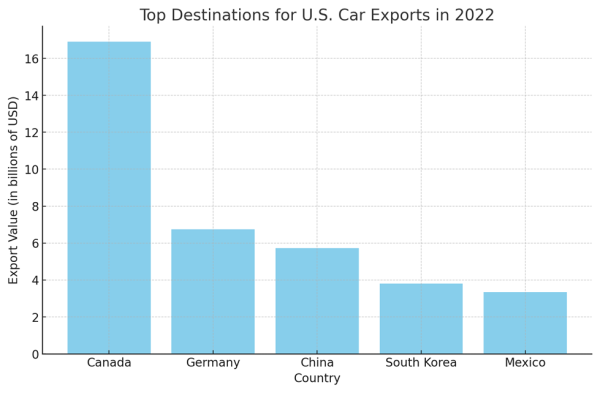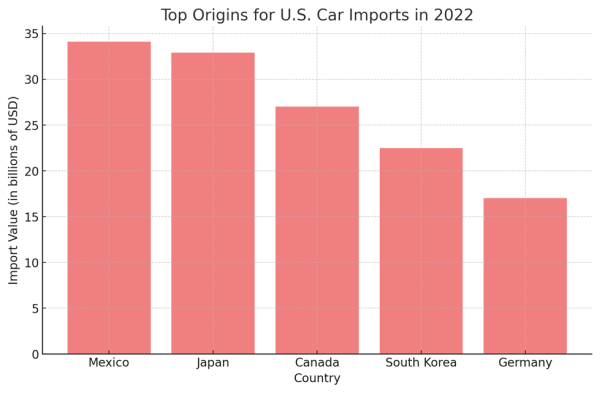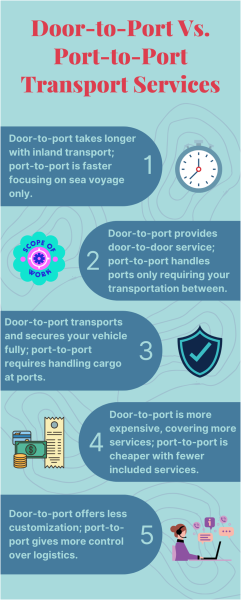International car shipping is not a piece of cake. It’s filled with confusion, budget constraints, paperwork, permits, and scams. Now, knowing how to navigate these challenges can spin anyone’s head. However, with port to port auto transport services, you can wave goodbye to these issues as the shipper handles your logistical and regulatory challenges. Read this guide to get a complete picture of international car shipping to and from the USA.
How Popular is International Car Shipping In The US?
International car shipping is only increasing with time, and it will be that way because the USA manufactures some of the finest vehicles in the world. Plus, people move to the USA from all over the world, and the same goes for people from the USA who move to different parts of the world.
Because of this relocation, many people take their vehicles with them, thus further boosting the demand for vehicle imports and exports to and from the USA, which calls for specialized car shipping services. Here’s 2022’s data from OEC regarding car exports from the USA.

As per the chart above, Canada is the largest export destination from the USA, followed by Germany, China, South Korea, and Mexico. Now, let’s look at the data on vehicle importation to the US.

As per the chart above, the US imports the most cars from Mexico, Japan, Canada, South Korea, and Germany.
This international car shipping in dollar values to/from the USA is in billions, indicating only one thing: the demand for overseas car shipping is super popular among Americans.
5 Difference Between Door-to-Port Transport & Port to Port Transport Services:
When it comes to international car shipping, there are two primary options: door-to-port and port-to-port transport services. Let’s explore the key distinctions in detail.

Transit Time:
Transit time is a significant factor differentiating door-to-port and port-to-port transport services. Door-to-port services generally involve longer overall transit times due to the inclusion of inland transportation.
This extended duration accounts for the time required to collect goods from the shipper’s location, transport them overland to the port, and complete any necessary customs procedures. In contrast, port-to-port services typically offer shorter transit times as they focus solely on the sea voyage between ports.
For example, a door-to-port shipment from a factory in central Germany to the Port of Hamburg, and then to New York, might take 20 days total, with 3 days for inland transit to Hamburg. A port-to-port service for the same route would only account for the 17-day sea voyage from Hamburg to New York, potentially saving 3 days in overall transit time.
Scope of Service Coverage
Door-to-port transport services offer a comprehensive solution. Your automobile is picked up from your doorstep and dropped off directly at the port of export and then from there to the destination port. In contrast, port-to-port transport only covers the journey from one port to another, requiring you to handle the pickup and delivery at either end.
| Feature | Door-to-Port Transport | Port-to-Port Transport |
| Pickup and Delivery | Pickup from your location and delivery to the port | Pickup and delivery must be arranged separately |
| Service Area | Nationwide coverage | Limited to specific port locations |
| Convenience | Highest level of convenience | Requires more coordination and effort from the shipper |
Responsibility for Cargo Handling
In door-to-port transport, the service provider is responsible for the entire process, including loading, unloading, and securing your vehicle during transit. With port-to-port transport, the shipper handles the cargo at the origin and destination ports.
- Door-to-port: The transport company handles cargo right from your doorstep
- Port-to-port: The shipper is responsible for moving the vehicle to/from the ports
Cost Structure and Pricing
Due to the additional services and logistics involved, door-to-port transport services typically have a higher price tag. On the other hand, port-to-port transport is generally a few hundred bucks less as the shipper takes on more responsibilities.
| Cost Factor | Door-to-Port Transport | Port-to-Port Transport |
| Pickup and Delivery | Included in the price | Shipper’s responsibility, additional cost |
| Cargo Handling | Included in the price | The shipper’s responsibility to/from the port |
| Overall Cost | Higher | Slightly Lower |
Flexibility and Control for Shippers
With port-to-port transport, shippers have greater control over the logistics and can tailor the process to their specific needs. Door-to-port services offer less flexibility, as the transport provider manages the entire journey.
| Aspect | Door-to-Port Transport | Port-to-Port Transport |
| Logistics Control | Limited control for the shipper | Greater control for the shipper |
| Customization | Less flexibility | More flexibility |
| Involvement | Shipper has a more passive role | The shipper is more actively involved |
Types of Port-to-Port Car Shipping Services:
Several transport methods are available for port-to-port car shipping to suit different needs and budgets. Let’s explore the main types of port-to-port car shipping services.
RoRo (Roll-on/Roll-off)
RoRo, or Roll-on/Roll-off, is popular for auto transport services between car shipping ports. This method drives vehicles onto and off the ship, making the loading and unloading process efficient and cost-effective. Due to its convenience and accessibility, RoRo is a preferred option for many shippers.
| Key Features | Vehicles are driven onto the shipIdeal for large-scale transport of vehiclesRelatively lower cost compared to other methods |
| Advantages | Faster loading and unloading processReduced handling of vehiclesSuitable for many vehicle types |
Container Shipping:
Container shipping is another option for port-to-port car shipping. This method involves loading your vehicle into a shipping container, which can be shared with other cargo (shared container) or dedicated solely to your vehicle (exclusive container). The choice between shared and exclusive containers depends on your specific needs and budget.
| Shared Container | Lower cost per vehicleSuitable for smaller shipmentsPotential for longer transit time |
| Exclusive Container | Dedicated space for your vehicleFaster and more secure transitHigher cost per vehicle |
Flat Rack
The flat rack method is another option for vehicle transport services between shipping ports. The vehicle is loaded onto a specialized open-top container and transported by the shipping carrier. This approach is often used for oversized or oddly shaped vehicles that may not fit into a standard container.
| Key Features | Open-top container designSuitable for oversized or irregularly shaped vehiclesRequires specialized handling equipment |
| Advantages | Accommodates a wider range of vehicle sizes and shapesProvides visibility and access to the cargo during transport |
LoLo (Lift-on/Lift-off)
The LoLo, or Lift-on/Lift-off, method involves using cranes or other specialized equipment to physically lift the vehicle onto and off the ship. This approach is often used for car shipping in US ports where RoRo facilities are unavailable or for vehicles that cannot be driven onto the ship.
| Key Features | Vehicles are lifted onto the ship by cranes or other equipmentRequires specialized handling equipment and expertiseSuitable for larger or heavier vehicles |
| Advantages | Accommodates a wider range of vehicle types and sizesUseful when RoRo facilities are not available |
How Much Will It Cost to Ship My Vehicle From a US Port to Another Country?
Shipping your vehicle from a US port to another country can be complex, with various factors influencing the final cost. To help you better understand, let’s explore the key elements that determine the price of this type of international auto transport service.
Factors Affecting the Cost of Port-to-Port Vehicle Shipping
The cost of shipping your vehicle from a US port to another country depends on several variables, including:
- Vehicle make, model, and size: Larger or heavier vehicles typically incur higher shipping costs.
- Destination country: The distance and logistics of transporting the vehicle to its final destination can significantly impact the price.
- Shipping method (RoRo, container, etc.): Different shipping methods have varying cost structures, with options like RoRo (roll-on/roll-off) generally being more affordable than container shipping.
- Fuel surcharges: Fluctuations in fuel prices can lead to variable fuel surcharges added to the base shipping cost.
- Additional fees and taxes: Depending on the destination country, you may need to account for customs duties, import taxes, or other fees associated with the vehicle’s clearance and transportation.
To illustrate these factors, let’s consider a hypothetical example. Shipping a mid-size sedan from the Port of Los Angeles to the Port of Auckland, New Zealand, using a RoRo service, may cost around $1,500 to $2,500, depending on the specific vehicle model and any applicable surcharges or fees. In contrast, shipping the same vehicle in a shared container could range from $2,000 to $3,000, while an exclusive container shipment may cost $3,500 to $4,500.
| Shipping Method | Estimated Cost Range |
| RoRo (Roll-on/Roll-off) | $1,500 -- $2,500 |
| Shared Container | $2,000 -- $3,000 |
| Exclusive Container | $3,500 -- $4,500 |
It’s important to note that these are just rough estimates, as the actual cost can vary based on your vehicle’s specifics and shipping requirements. To get a more accurate quote, it’s recommended that you contact a reliable international auto transport provider and provide them with the necessary details about your vehicle and shipping needs.
How Much Will It Cost to Ship My Vehicle to a US Port From Another Country?
Shipping your vehicle from another country to a US port has several factors affecting the final cost. These variables can help you plan and budget to import your car, truck, or SUV to the United States.
One of the primary cost considerations is the country of origin. Shipping from closer locations like Canada or Mexico may be more affordable due to road links and shorter distances than transporting your vehicle from Europe or Asia. Your vehicle’s make, model, and size also play a role, as larger or specialty vehicles typically incur higher shipping fees.
| Shipping Route | Average Cost (USD) |
| Canada to US Port | $800 -- $1,500 |
| Mexico to US Port | $900 -- $1,800 |
| Europe to US Port | $1,500 -- $3,000 |
| Asia to US Port | $2,000 -- $4,500 |
The hauling method you select can also affect the cost. Roll-on/roll-off (RoRo) transport is typically more affordable than container shipping, but the latter offers greater protection and security for your vehicle. Key factors that can affect the final price.
- Shipping method (RoRo, container, etc.)
- Make, model, and size of your vehicle
- Origin country and distance to the US port
- Customs fees, taxes, and currency exchange rates
Researching reputable auto transport companies and obtaining multiple quotes can also help you get the best deal for your needs.
General Customs Regulations for Port-to-Port Auto Transport Services From US:
When shipping your vehicle from a US port to an international destination via port-to-port auto transport services, it’s crucial to be aware of the general customs regulations that apply. These regulations ensure a smooth and compliant international car shipping experience.
First and foremost, you’ll need to provide the necessary documentation, typically including a copy of your vehicle’s title or registration, a commercial invoice, and any required import permits or licenses for the destination country. Additionally, your vehicle may be subject to a thorough inspection at the port of entry to ensure it meets the destination’s safety and emissions standards.
Import taxes and duties will also need to be accounted for, and these can vary widely depending on the destination country, the vehicle’s value, and any applicable trade agreements. It’s essential to research the specific customs requirements and associated costs for your destination to avoid any unexpected fees or delays.
| Destination Country | Import Tax Rate | Documentation Required |
| Canada | 6.1% of the vehicle’s value | Title, registration, commercial invoice, BoL |
| United Kingdom | 10% of the vehicle’s value Customs Duty & 20% VAT | Title, registration, commercial invoice, import permit |
| Australia | 5% of the vehicle’s value | Title, registration, commercial invoice, import license |
Finally, it’s important to know specific rules or restrictions for the destination country, such as age limits on imported vehicles, emissions standards, or certain vehicle types.
Top Car Shipping Ports in USA by Value of Shipments Handled:
There are over 300 US ports, and they all see some cargo handling activities. However, the top USA seaports for cars have values in billions of dollars and handle millions of TEUs every year. Here are the top USA seaports for cars listed by the value of shipments they handle.
Los Angeles, CA
Known as America’s Port, it is the busiest in the US and handles over 9 million TEUs annually.
- Value: $196.9 billion
New York, NY
Largest USA seaport on the East Coast, handling diverse cargo such as containers, petroleum, and consumer goods.
- Value: $187.1 billion
Long Beach, CA
Close to Los Angeles Port, it handles significant US-Asian trade.
- Value: $147.5 billion
Houston, TX
The busiest USUSeaport for foreign waterborne tonnage, the largest in the Gulf of Mexico, handles diverse commodities.
- Value: $124.7 billion
Savannah, GA
4th busiest in the US and the largest single container terminal in North America.
- Value: $102.9 billion
Charleston, SC
The 8th busiest container facility handles containerized and breakbulk cargo.
- Value: $72 billion
Norfolk, VA
Accessible to the Atlantic Ocean, it accommodates the largest container vessels, significant for trade.
- Value: $70.7 billion
Oakland, CA
9th busiest container port, major for trade with Asia, exports agricultural goods, technology, and wine.
- Value: $50.7 billion
Make Sure to Hire an International Car Transport Broker For a Safely & Timely Move:
It’s difficult to trust someone with your vehicle; you may wonder if they’ll ship my vehicle as promised or cut corners. What if they mishandle the automobile and damage it? What if they add more charges at the end quote under any kind of expense?
It’s impossible to monitor the vehicle during transit, nor is it easy to get accountability for all the charges. So then, how do you get car shipping to a port from one port?
Only by hiring top-rated international port-to-port auto transport services. You’ll have to look at their online reputation on platforms like Google Reviews, BBB, Transport Reviews, and BirdEye. Then you check their credentials such as license, insurance, permits, etc. And then, you talk to their team, check their support response, and maybe even talk to a few past customers.
These are the precautions you must take to ensure your international auto transportation experience offers the best value for your money.

